Ignoring the result for a moment, there were some great ideas and innovations in digital campaigning leading up to the UK General Election.
With high stakes and the knowledge that the online battleground was more important than ever, all sides poured time, money, and energy into finding out what works.
We’ve collected some of our favourite examples to inspire digital campaigners and fundraisers.
Repurposing content across channels
It flies in the face of best practice, but many of the most shared and liked posts from Jeremy Corbyn’s Facebook page are the simplest: screenshots of tweets. It’s not a new approach but interesting to see it being used to this extent, and it’s been extremely effective.
The screenshot/image format means that these simple statements are more attention-grabbing than a standard Facebook text post. They’re also easy to make and require no design ability. And they often get shared – a lot.
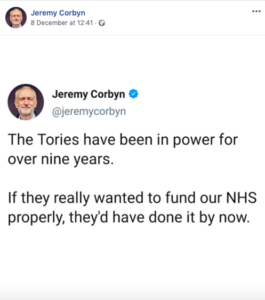 .
. 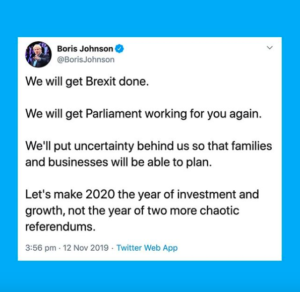
The format probably taps into the desire to share content that says what we’d like to say ourselves, but better! It’s also authentic and DIY, which we like to see from our politicians.
In terms of what we can learn, part of the appeal is probably that they come from a ‘real person’, so these Twitter quotes might not do so well from an organisation’s account. But it’s worth a test – just remember to keep your screenshots square for Instagram!
Localised events and maps
Momentum’s campaign map was a great digital organising tool, which clearly showed supporters where relevant, local events were.
Unlike traditional event tools which collate any and all events, this one made recommendations based on where you could make the most difference, depending on the marginals near you and where extra people were most needed.

It’s tough to make an event map work – often they don’t have enough events to be useful, or otherwise they rely on volunteers updating them frequently so they’re not incomplete or out of date.
So it’s brilliant to see something so strategic, targeted and useful created in this general election campaign. This wired article explains the data driven approach and how they used a small amount of staff time and many volunteers.
Engagement tools with personal relevance
Labour’s fair tax calculator is a great example of an engagement tool that has personal value and also contributes to a wider campaign message.
The first time they tweeted this, it was re-tweeted over 14k times.
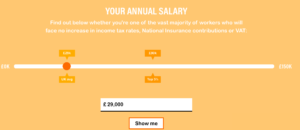
We know that engagement tools work best when they offer people a specific, relevant and personal piece of information – and they’re even better when they’re shareable.
A few of our recent favourites that we’ve built for our clients include the Mayor of London’s How Many Londoners Do Your Tube Journey Every Day?, 350.org’s carbon calculator, and of course Labour’s NHS baby number estimator.
Fundraising for Facebook advertising
With Facebook advertising now being a highly contentious influencer of the political debate, it appears that people are prepared to directly fund ads that get their side of the argument out there, or further a cause they believe in.
Led By Donkeys raised over £300k to ‘counter Boris Johnson’s Facebook ad blitz’ with ‘powerful, factual and emotional content’ that would be more persuasive than ‘fake news’.
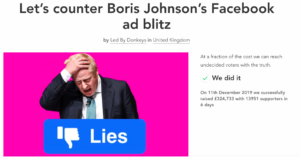
And a Momentum email also claimed they had raised over £100k to ‘reach young people in marginals on social media and make sure they vote Labour’.
It won’t work for everyone, but it’s a tangible fundraising ask that could be worth trying for other campaigns.
Customisable content
Momentum’s campaign planner tool was an ambitious attempt to get supporters and activists to think about small, medium and big actions they could take, and to create and commit to a personal plan of action leading up to the election.
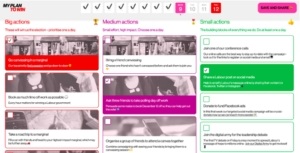
Meanwhile on Labour’s website you could create your own manifesto based on the things that mattered most to you, and share your personal reasons for voting Labour.
We already know that personalisation can drive up engagement – like first names in email subject lines, or personalised user journeys in engagement tools, for example – so this is a great example of a campaign making supporter-centric content.
We’ve recently done something very similar with Greenpeace, where you can create your own anti-plastic graphics to target supermarkets.
Engaging communities with a reciprocal offer
The ‘McVoteFace’ website encouraged people who live on boats and don’t have a fixed address to register to vote in a marginal constituency, if they had a personal link to it. It’s a nice example of a campaign tailored to the particular difference a small group of people can make.
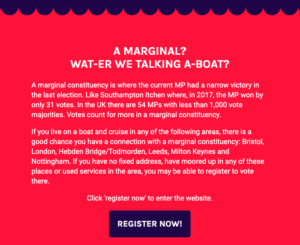
This was alongside stories like the Bristol brewery offering homeless people a place to register to vote, and Uber offering free rides to polling stations for disabled or elderly people.
While the latter might have been more of a PR stunt than a genuine attempt to turn out the vote, all three were successful in being “good news stories” in an otherwise scrappy (and cold!) election. Make sure you’re always on the lookout for opportunities like this.
The good, the bad, and the… funny?
This isn’t a new tactic but we have to give it to the Tories for having the wittiest take downs, and generally bringing some surprising humour to their campaign. This is one example:

While we don’t always recommend organisations opt for such a salty strategy, a little bit of sass or a pun can sometimes bring otherwise dry messaging to life!
And finally, what not to do…
There were a few digital campaign clangers that should also be learned from, too. In particular:
- Don’t change your Twitter handle in a stunt that might backfire. The Conservative Party’s press office decision to rebrand their Twitter as a fact-checking service during a televised leader’s debate was criticised heavily.
- Get your stats right. The Lib Dems got a lot of criticism for misleading graphs, so let’s make sure our infographics are factual!
If you’ve seen any other interesting ideas that you think could inspire campaigners, or you’ve been inspired to create something from this blog, we’d love to know. Drop us an email on hello@forwardaction.uk.